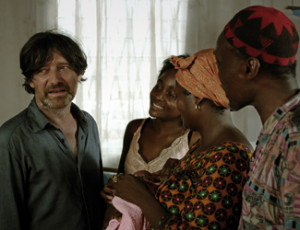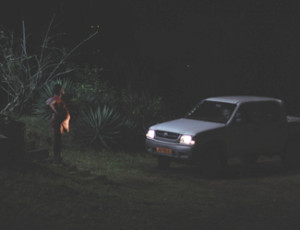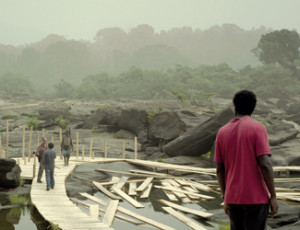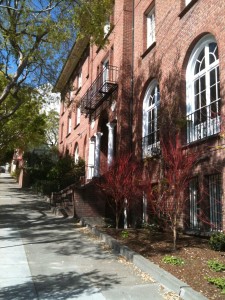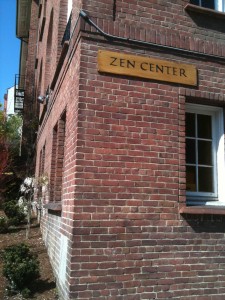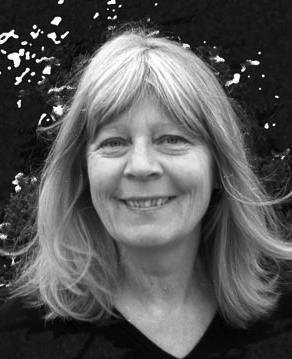Für den Frauenmonat März hier meine Erinnerungen an FRAUEN HINTER DER KAMERA
Von 1989 bis 2009 gehörte ich beim Goethe-Institut San Francisco zu den Frauen hinter der Kamera, die zwar keine Filme gemacht haben, aber zahlreiche Filmprogramme, oft mit der Kamera in der Hand, und sogar vor der Kamera zusammen mit Regisseurinnen wie Doris Dörrie, Monika Treut, Nina Grosse, Bettina Oberli oder Erica von Möller. Schon in den achziger Jahren waren Frauen im Filmprogramm des Goethe-Instituts sehr präsent. Ich erinnere mich an “ausverkaufte” Filmabende schon lange vor meinem Amtsantritt (damals zahlte man noch keinen Eintritt) mit Ulrike Ottinger, Helke Sanders und Helma Sanders-Brahms. Manfred Triesch veranstaltete legendäre Parties, wo ich u. a. Margarete von Trotta kennenlernte. Zu einer meiner ersten Filmveranstaltungen, die mir in Erinnerung geblieben ist, kam Ulrike Ottinger 1990 mit ihrem Film COUNTDOWN ins Goethe-Institut. Sie setzte sich lächelnd mitten in den anfangs noch vollen Saal. Ihr Lächeln verschwand aber, als immer mehr Leute den langen Film auf den harten Stühle nicht durchsitzen konnten und den Raum verließen. Der Countdown im Saal entfaltete sich als Gegenstück zum Countdown auf der Leinwand, der mit jubelnden Massen beim Fall der Mauer endete.
Die Filmtradition fortzusetzen und auszuweiten machte ich, als Programmfrau, zu meiner Hauptaufgabe, die sich bald zu einer wahren Leidenschaft entwickelte. 1996 wurde mit Hilfe von Institutsleiter Ulrich Sacker auf meine Anregung hin BERLIN & BEYOND ins Leben gerufen, ein einwöchiges Filmfestival, das endlich die vielen hervorragenden deutsch-sprachigen Filme auf großer Leinwand zeigen sollte, die sonst nirgens in San Francisco zu sehen waren. Mit dem Goethe-Institut als Veranstalter und dem wunderschönen Castro Kino als Partner boten sich ungeahnte Möglichkeiten und große Herausforderungen. Die 1500 Plätze im Castro auch nur zur Hälfte mit einem Publikum zu füllen, das weder die deutschen Schauspieler noch die Namen der Regisseure und schon gar nicht die der Regisseurinnen kannte, würde keine leichte Aufgabe sein. In den fünfzehn Jahren, die ich mit dem Festival zu tun hatte, wuchs B&B schließlich so an, daß das Kino manchmal ausverkauft, oft voll und meistens so gut besetzt war, daß die deutschen Gäste voller Staunen waren. Und natürlich gab es unter ihnen immer mehr Frauen, oft Absolventen deutscher Filmschulen, die aufgrund einer umfangreichen Filmförderungspolitik eine erfolgreiche Zukunft im Filmgeschäft versprachen.
Amerika habe ich als Quotenland kennengelernt. Ein Filmprogramm ohne Regisseurinnen zu veranstalten, war für mich als Leiterin des Festivals undenkbar, was sich nun, viele Jahre später beim Durchblättern der Berlin & Beyond Programme bestätigt. 1996, zum Eröffnungsfestival, stand MEIN LIEBER MANN von Eva-Maria Bahlrühs auf dem Programm und schon zwei Jahre später waren vier Regisseurinnen von insgesamt etwa zwanzig Filmemachern eingeladen. 2009 war der Anteil der Frauen auf weit über 30% gestiegen. Einige Namen tauchen immer wieder im Programm auf, wie Doris Dörrie, Barbara Albert (Österreich), Angela Schanelec und Caroline Link. Oft entpuppten sich aber kleine Filme von unbekannten Frauen als große Publikumserfolge, wie BIN ICH SCHÖN von Katinka Feistl, FRÄULEIN STINNES REIST UM DIE WELT von Erica von Möller oder Nathalie Steinbarts ENDSTATION TANKE und Birgit Möllers VALERIE, die beide mit $5000 und dem Best First Feature Award des Festivals ausgezeichnet wurden. In fünfzehn Jahren lernte das Publikum bei Berlin & Beyond über sechzig Filmemacherinnen kennen, deren Filme, bis auf wenige Ausnahmen, nicht in US Kinos gezeigt werden. Nur Carline Link, Doris Dörrie, Margarete von Trotta und Monika Treut, die Veteranen unter den Regisseurinnen, werden oft von US Verleihern gekauft. Gab es typisch weibliche Themen oder Sichtweisen? Gewalt, Kriegsverbrechen, die Brutalität der Neonazis waren selten ihr Fokus, vielmehr ging es um Beziehungsgeschichten, Frauenschiksale, historische, dramatische oder romatische Stoffe. Eine Ausnahme ist Brigitte Barteles Film NACHT VOR AUGEN, der auf viel subtilere Weise als Kathryn Bigelows THE HURT LOCKER das Kriegstrauma eines Soldaten beschreibt. Bigelow bekam 2010 als erste Regisseurin einen Oscar für ihren Film.
Publikumsliebling bei Berlin & Beyond war Doris Dörrie. Wenn sie in roten Turnschuhen, Stretchhosen und weißer Windjacke auf die Bühne sprang, jubelten die Zuschauer im vollgepackten Kino und gaben auch einem Film wie NAKED soviel Zuspruch, daß man nach zusätzlichen Beweggründen für soviel Begeisterung sucht. Der Titel half sicher und vielleicht auch ihre enge Verbindung zum Zen Center in San Francisco. Doris Dörrie und ihre Filme zogen auf jeden Fall genauso so wie Fatih Akin, Tom Tykwer, Wim Wenders oder Werner Herzog, die alle bei uns zu Gast waren.
Hollywood hat mit seiner mächtigen über hundert Jahre alten Filmindustrie kaum Regisseurinnen hervorgebracht und 2010 zum ersten Mal einer Frau den Oscar für “Best Director” gegeben. Deutschland dagegen hat aufgrund seiner besseren Finanzierungspolitik den Frauen im Filmgeschäft eine viel breitere Unterstützung ermöglicht, die auch Studentenfilmen Türen öffnen und Wege bahnen kann, die zwar selten zu den Oscars, aber oft bis nach San Francisco zu Berlin & Beyond geführt haben.

